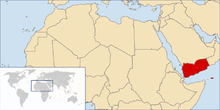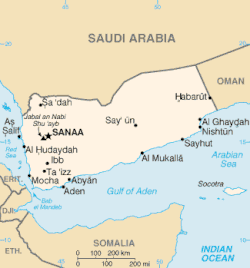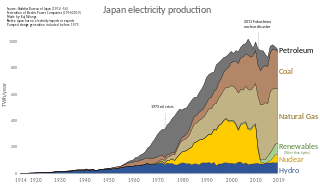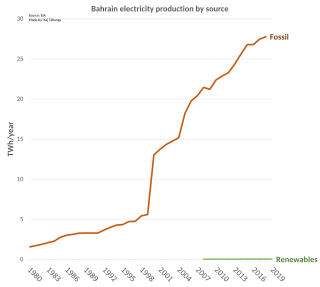



Energy in Yemen describes energy and electricity production, consumption and import in Yemen. Yemen is net energy exporter.
Contents
Primary energy use in Yemen was 87 TWh and 4 TWh/million people in 2008 and 88 TWh (4 TWh/M) in 2009. [1]




Energy in Yemen describes energy and electricity production, consumption and import in Yemen. Yemen is net energy exporter.
Primary energy use in Yemen was 87 TWh and 4 TWh/million people in 2008 and 88 TWh (4 TWh/M) in 2009. [1]
According to the World Bank, Yemen has the lowest level of electricity connection in the Middle East, with only 40% of the population having access to electricity. Rural areas are particularly badly affected. Industrial concerns, hospitals and hotels have their own back-up generators. To address these shortages, a 340-MW gas-fired power plant is currently under construction-and close to completion-at Marib. Further expansion to the facility, which will add an additional 400 MW of output, is already planned. Yemen has received considerable support for the development of its power generation network in recent years, with contributions coming from Saudi Arabia, France, the US, as well as multilateral donors such as the World Bank. Consequently, a National Rural Electrification Program is now in place and the construction of three substations, along with the necessary transmission lines, is currently under way. Yemen is also looking into the development of wind power, although plans for the construction of a nuclear power generating facility have been shelved. Electrical production is 5.665 billion kWh (2007 estimate). Electrical consumption is about 4.133 billion kWh. [2]
| Energy in Yemen [3] | ||||||
|---|---|---|---|---|---|---|
| Capita | Prim. energy | Production | Export | Electricity | CO2-emission | |
| Million | TWh | TWh | TWh | TWh | Mt | |
| 2004 | 20.33 | 74 | 240 | 153 | 3.36 | 17.26 |
| 2007 | 22.38 | 84 | 192 | 102 | 4.50 | 20.55 |
| 2008 | 23.05 | 87 | 177 | 92 | 5.04 | 21.93 |
| 2009 | 23.58 | 88 | 177 | 93 | 5.11 | 22.18 |
| 2010 | 24.05 | 83 | 230 | 139 | 5.98 | 21.65 |
| 2012R | 23.85 | 80.5 | 176 | 94 | 4.23 | 19.97 |
| 2013 | 24.41 | 96.2 | 212 | 114 | 6.31 | 23.92 |
| Change 2004-10 | 18.3% | 12.6% | -4.1% | -9.1% | 78.0% | 25.4% |
| Mtoe = 11.63 TWh, Prim. energy includes energy losses. 2012R = CO2 calculation criteria changed, numbers updated | ||||||
Yemen population increased 16.0% in five years 2004-2009. According to OECD/World Bank population growth in Yemen was from 20 million to 24 million in 6 years (2004-2010). [4]
Yemen LNG (YLNG) is the first Liquefied natural gas (LNG) project in Yemen.

Energy in Japan refers to energy and electricity production, consumption, import and export in Japan. The country's primary energy consumption was 477.6 Mtoe in 2011, a decrease of 5% over the previous year.

Ensuring adequate energy supply to sustain economic growth has been a core concern of the Chinese government since 1949. The country is the world's largest emitter of greenhouse gases, and coal in China is a major cause of global warming. However, from 2010 to 2015 China reduced energy consumption per unit of GDP by 18%, and CO2 emissions per unit of GDP by 20%. On a per-capita basis, it was the world's 51st largest emitter of greenhouse gases in 2016. China is also the world's largest renewable energy producer. China is the largest producer of hydroelectricity, solar power and wind power in the world. The energy policy of China is connected to its industrial policy. The goals of China's industrial policy dictate its energy needs.

Energy in Mexico describes energy and electricity production, consumption and import in Mexico.

Energy in Belgium describes energy and electricity production, consumption and import in Belgium.

Energy in Angola describes energy and electricity production, consumption and export from Angola. The energy policy of Angola reflects energy policy and the politics of Angola.

This article describes the energy and electricity production, consumption and import in Egypt.

The electricity sector in Belgium describes electricity in Belgium. Production by power source in 2009 was 53% nuclear, 40% fossil electricity and 7% renewable electricity. 2% of production was exported in 2009. In 2008 import was 11%. Belgium is highly nuclear dependent country where the share of renewable electricity has been low. The share of renewable electricity was about 2% in 2005. Plan for 2020 is wind 10.5 TWh (9.5%), biomass 11 TWh and PV 1 TWh.

Energy in Qatar describes energy production, consumption, and policies of the State of Qatar. The International Monetary Fund ranked Qatar as having the fifth highest GDP per capita in 2016 with a 60,787 USD per capita nominal GDP over a population of 2.421 million inhabitants. In 2014, oil and natural gas production made up 51.1% of Qatar's nominal GDP. Thus, Qatar has a worldwide high ranking of per capita GDP due to its significance production and exports in both crude oil and natural gas in proportion to its relatively small population.
Energy in Kuwait describes energy and electricity production, consumption, import and export in Kuwait.
Energy in Libya describes energy and electricity production, consumption, and import in Libya. The petroleum industry is the primary engine of the Libyan economy.

Energy in Algeria describes energy and electricity production, consumption and import in Algeria. Primary energy use in 2009 in Algeria was 462 TWh and 13 TWh per million persons. Algeria is an OPEC country.
Energy in the United Arab Emirates describes energy and electricity production, consumption and import in the United Arab Emirates (UAE). UAE has 7% of global proved oil reserves, about 100 billion barrels. Primary energy use in 2009 in UAE was 693 TWh and 151 TWh per million persons.
Energy in the Czech Republic describes energy and electricity production, consumption and import in the Czech Republic.

Energy in Bahrain describes energy and electricity production, consumption and import in Bahrain. Baharain is net energy exporter.

Energy use in Oman was 381 TWh in 2020, almost double the consumption in 2010.

Energy in Belarus describes energy and electricity production, consumption and import in Belarus. Belarus is a net energy importer. According to IEA, the energy import vastly exceeded the energy production in 2015, describing Belarus as one of the world's least energy sufficient countries in the world. Belarus is very dependent on Russia.
Lithuania is a net energy importer. Primary energy use in Lithuania was 98 TWh, or 29 TWh per million people in 2009.
Latvia is a net energy importer. Primary energy use in Latvia was 49 TWh, or 22 TWh per million persons in 2009. In 2018, electricity consumption per capita was 3731 kWh.
Energy in Luxembourg describes energy and electricity production, consumption and import in Luxembourg. Energy policy of Luxembourg will describe the politics of Luxembourg related to energy in greater detail. Electricity sector in Luxembourg is the main article of electricity in Luxembourg.

Primary energy use in Slovakia was 194 TWh and 36 TWh per million inhabitants in 2009.